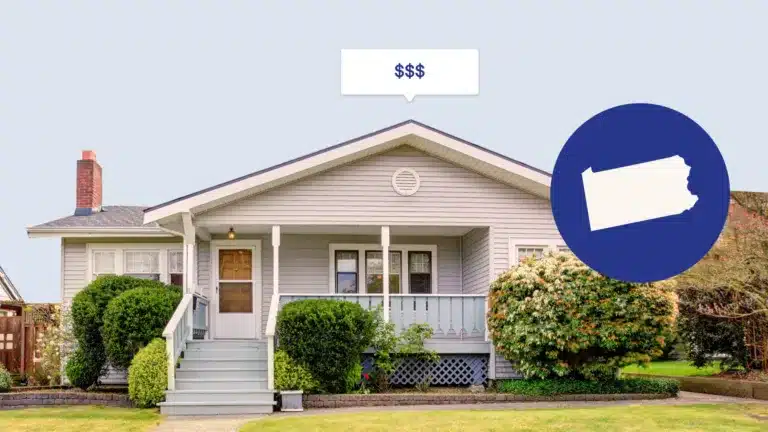You may have heard of the term “annual percentage rate (APR)” but might not understand exactly what it means.
But just like other important mortgage terms like rate lock, it’s important to understand APR from top to bottom because it affects how much you pay for your mortgage over the long term.
We’ll cover some APR basics to help you understand the answer to the question, “What is APR?” and how it can affect your mortgage over the long term. We’ll also walk through the types of APR, how it’s different from a mortgage interest rate, how to calculate APR and more.
What is APR?
APR represents the cost of borrowing over the life of your mortgage loan, expressed as an annual rate. An APR gives you a rounder picture of how much your mortgage will cost you. And it’s more than just the interest rate — it also includes points and fees the lender charges.
APR is important because it offers a holistic overview of the total cost of a loan. Many borrowers choose a mortgage lender based on the APR it offers.
How Does APR Work?
When applying for a mortgage loan, borrowers can use the APRs from various lenders to distinguish between all of the different combinations of interest rates, discount points and fees.
However, be careful when you compare the APRs of adjustable rate mortgage loans (ARMs) because you won’t know the maximum interest rate of any of them — the rates are variable.
Comparing the APRs of fixed-rate loans and ARMs isn’t an apples-to-apples comparison because one interest rate stays the same and ARMs change.
How is APR Calculated?
You can use the following APR calculation to understand the total cost of APR:
APR = (((Fees + Interest) / Principal / n) x 365) x 100
(n = Total days in the loan term)
- Add the fees and total interest to be paid over the life of the loan.
- Divide that sum by the loan principal.
- Divide that result by the total days in the loan term (n).
- Multiply the result by 365.
- Multiply the final result by 100 to get the APR as a percentage.
Or if you’d rather avoid the math problem, you can use a loan calculator instead, like the Experian APR calculator. These tools can help you calculate APR based on the amount you plan to borrow and a few other key factors such as finance charges, interest rate and loan term.
It’s also worth noting that you won’t usually have to calculate the APR on your own because the Federal Truth in Lending Act requires lenders to tell you your APR. For example, you’ll find both the interest rate and the APR on the Loan Estimate and the Closing Disclosure, both of which summarize the terms of your loan in clear language.
What Affects Your APR?
Several factors go into determining your APR, but the good news is you have influence over several of them, including:
- Credit score: Lenders will likely consider your credit score when offering you an interest rate. You’re more likely to get a lower interest rate if you have an excellent (high) credit score. You can raise your credit score by paying bills on time, trying not to carry a balance on your credit cards and aiming to reduce your credit utilization (the amount of your credit limit you use).
- Debt-to-income (DTI) ratio: Your DTI refers to your monthly recurring bills divided by your gross monthly income. Lenders generally want to see a DTI ratio of less than 43%.
- Payment history: The more on-time payments you make can result in a lower APR.
- Down payment: Making a larger down payment may qualify you for a lower rate.
- Loan terms: A longer loan term typically means a higher APR (but note this isn’t always the case).
- Interest rate type: Fixed-rate loans charge the same fixed APR throughout the life of the loan (the loan term). Variable rate loans fluctuate, meaning you could potentially save money but also be charged more if rates go up.
Remember: It’s a good idea to shop around for a lower APR among all of your loan options.
APR vs. Interest Rate
The interest rate is a percentage of the loan principal that a lender charges you to borrow money. It does not reflect fees or any other charges you may have to pay.
Compared with the interest rate, APR is a more expansive measure of the cost of borrowing money.
The APR will usually be higher than the interest rate because it encompasses all the extra costs of taking out a loan.
What is a Good APR for a Mortgage?
It’s not easy to define a “good” APR, considering that many factors go into it. This includes your mortgage type and personal factors such as your credit score, income, job history, assets, debt-to-income ratio and other factors.
However, you can get a feel for whether you’ve received a “good” APR from a lender by comparing the APR you’ve been given to the prevailing interest rate in relation to the U.S. Prime Rate or another standard index.
Ready to learn more from Morty? You can read about topics for your own home buying journey, like “What is an appraisal?” and home equity loan pros and cons in the Morty blog.






